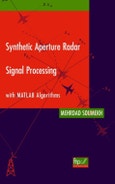An up-to-date analysis of the SAR wavefront reconstruction signal theory and its digital implementation With the advent of fast computing and digital information processing techniques, synthetic aperture radar (SAR) technology has become both more powerful and more accurate. Synthetic Aperture Radar Signal Processing with MATLAB Algorithms addresses these recent developments, providing a complete, up-to-date analysis of SAR and its associated digital signal processing algorithms. This book introduces the wavefront reconstruction signal theory that underlies the best SAR imaging methods and provides clear guidelines to system design, implementation, and applications in diverse areas-from airborne reconnaissance to topographic imaging of ocean floors to surveillance and air traffic control to medical imaging techniques, and numerous others. Enabling professionals in radar signal and image processing to use synthetic aperture technology to its fullest potential, this work:
Provides practical examples and results from real SAR, ISAR, and CSAR databases
Outlines unique properties of the SAR signal that cannot be found in other information processing systems
Examines spotlight SAR, stripmap SAR, circular SAR, and monopulse SAR modalities
Discusses classical SAR processing issues such as motion compensation and radar calibration
Provides practical examples and results from real SAR, ISAR, and CSAR databases
Outlines unique properties of the SAR signal that cannot be found in other information processing systems
Examines spotlight SAR, stripmap SAR, circular SAR, and monopulse SAR modalities
Discusses classical SAR processing issues such as motion compensation and radar calibration
Table of Contents
Range Imaging.Cross-Range Imaging.
SAR Radiation Pattern.
Generic Synthetic Aperture Radar.
Spotlight Synthetic Aperture Radar.
Stripmap Synthetic Aperture Radar.
Circular Synthetic Aperture Radar.
Monopulse Synthetic Aperture Radar.
Bibliography.
Index.








